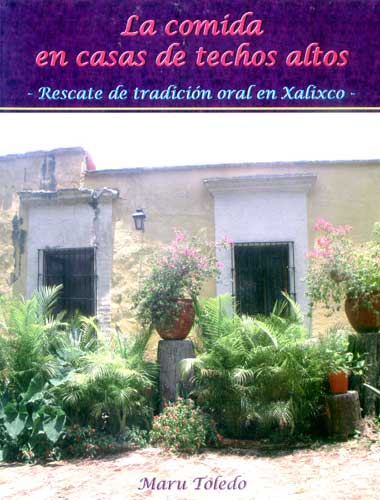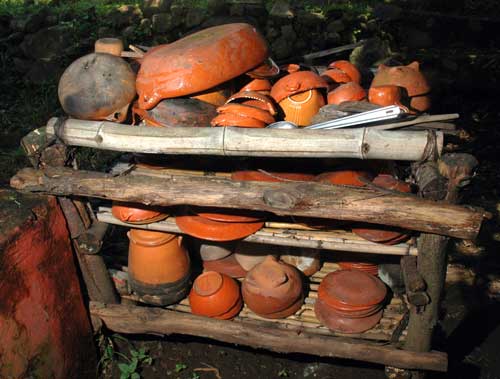CULINARY DELIGHTS OF YESTERYEAR
New cookbook offers old recipes and much more
By John Pint
 On
September 9, 2007, Jalisco’s “culinary queen” Maru Toledo, launched her eleventh
cookbook in a ceremony held in the picturesque Hacienda del Carmen, located nine
kilometers southwest of the pyramids of Teuchitlán.
On
September 9, 2007, Jalisco’s “culinary queen” Maru Toledo, launched her eleventh
cookbook in a ceremony held in the picturesque Hacienda del Carmen, located nine
kilometers southwest of the pyramids of Teuchitlán.
María Eugenia Toledo Vargas goes by her nickname Maru and is well known in
Jalisco as the founder of the Research Center for the Rescue of the Oral and
Gastronomic Tradition of the Valles Region. Maru’s new book is titled “La Comida
en Casas de Techos Altos” (Food in Houses with High Ceilings) and is dedicated
to “the rescue of oral tradition in Xalixco,” which alerts the reader to the
fact that this is much more than a cookbook. In fact, the new publication comes
with a CD that reproduces a hymn at least 300 years old, which was sung by
patrones and campesinos alike during the first sowing of seeds in the fields.
The compact disk also contains interviews with old-timers, as does the book. A
most interesting interview is hidden away between the recipe for Panile de
Semilla (Pumpkin Seed Powder) and Agua de Durazno (Peach Juice Drink) and
doesn’t even appear on the contents page. In this interview, eighty-year-old Don
Isidro talks about meeting Emiliano Zapata and describes the nearly impossible
life of the campesinos before the Revolution. As a seventeen year old, he was
required to rise at two or three in the morning and walk twelve kilometers to
bring in and feed the oxen with which he had to plow the fields at first light.
“And if one of us didn’t appear at sunrise, he got no food for all the rest of
the week…and what was he going to eat? What was he going to eat? We hated the
hacendados (hacienda owners) with a great hate… and then one day the government
(under Zapata) arrived and opened the stores, which were brimming with corn.
‘Come on, ladies, take what you need,’ shouted the Federales…and they forced the
hacendados to give us ejidos, plows, yokes, carts, everything we needed, and
after that, life was beautiful because now all the people could work for
themselves.”
Of course, this unusual cookbook also has plenty of recipes, each of which, as
you might expect, is accompanied by charming memoirs of bygone days. For
example, to make oatmeal cookies you need:
260 grams of butter
175 grams of sugar
3 eggs
250 grams of flour
1 teaspoon of baking powder
200 grams of oatmeal
 In the
course of explaining what to do with these ingredients, we meet Tía Rosaura, the
aunt who gave Maru the recipe and Rosaura’s lovely cat which must have learned
all the cooking secrets of the house while spying on the kitchen from up in the
attic. We also learn all about her aunt’s bedroom where a long-dead pretender,
still in love with her, would come to sit on her bed at night to caress her
tenderly. Next to the bed was a “ridiculous white bathtub with twisted legs,”
and above it, a curious shower. Pulling on one of two chains would bring down a
spray of hot or cold water which Maru “always dreamed of using” but never got a
chance to try.
In the
course of explaining what to do with these ingredients, we meet Tía Rosaura, the
aunt who gave Maru the recipe and Rosaura’s lovely cat which must have learned
all the cooking secrets of the house while spying on the kitchen from up in the
attic. We also learn all about her aunt’s bedroom where a long-dead pretender,
still in love with her, would come to sit on her bed at night to caress her
tenderly. Next to the bed was a “ridiculous white bathtub with twisted legs,”
and above it, a curious shower. Pulling on one of two chains would bring down a
spray of hot or cold water which Maru “always dreamed of using” but never got a
chance to try.
And the cookies? “The first thing we did was to beat the butter with the sugar
until it became creamy. Then we added the eggs one by one, always continuing to
beat the mixture. After that, we added the flour strained with the baking
powder. Finally, we added the oatmeal. We put blobs of dough on the greased
trays and pushed them into the oven.”
Besides recipes and folklore, La Comida en Casas de Techos Altos also contains
the first chapter of a novel which, as you might suspect, has much to do with an
old hacienda, a book of recipes and Aunt Eugenia, after whom, it appears, a
commercial brand of butter (recommended by Maru) was named. It should also be
mentioned that this cookbook comes with an enormous collection of photos and
drawings showing colonial kitchens, cooking implements and techniques (like the
“nixtamalization” process) and even a picture of Aunt Rosaura’s cat.
 At the book launching, several original melodies were played on the panpipes by
Maru’s colleague, Godofredo Oseguera, co-director of the research center. If you
are interested in taking a cooking class taught by Maru and Godofredo
themselves, you may want to contact their school in Teuchitlán, the Jardín
Mestizo, which has been specializing in prehispanic gastronomy for over nine
years. Just call Maru’s cell phone number: 044 333 839 9941 or send us an
email which we will forward to her.
At the book launching, several original melodies were played on the panpipes by
Maru’s colleague, Godofredo Oseguera, co-director of the research center. If you
are interested in taking a cooking class taught by Maru and Godofredo
themselves, you may want to contact their school in Teuchitlán, the Jardín
Mestizo, which has been specializing in prehispanic gastronomy for over nine
years. Just call Maru’s cell phone number: 044 333 839 9941 or send us an
email which we will forward to her.
HOME
 On
September 9, 2007, Jalisco’s “culinary queen” Maru Toledo, launched her eleventh
cookbook in a ceremony held in the picturesque Hacienda del Carmen, located nine
kilometers southwest of the pyramids of Teuchitlán.
On
September 9, 2007, Jalisco’s “culinary queen” Maru Toledo, launched her eleventh
cookbook in a ceremony held in the picturesque Hacienda del Carmen, located nine
kilometers southwest of the pyramids of Teuchitlán. In the
course of explaining what to do with these ingredients, we meet Tía Rosaura, the
aunt who gave Maru the recipe and Rosaura’s lovely cat which must have learned
all the cooking secrets of the house while spying on the kitchen from up in the
attic. We also learn all about her aunt’s bedroom where a long-dead pretender,
still in love with her, would come to sit on her bed at night to caress her
tenderly. Next to the bed was a “ridiculous white bathtub with twisted legs,”
and above it, a curious shower. Pulling on one of two chains would bring down a
spray of hot or cold water which Maru “always dreamed of using” but never got a
chance to try.
In the
course of explaining what to do with these ingredients, we meet Tía Rosaura, the
aunt who gave Maru the recipe and Rosaura’s lovely cat which must have learned
all the cooking secrets of the house while spying on the kitchen from up in the
attic. We also learn all about her aunt’s bedroom where a long-dead pretender,
still in love with her, would come to sit on her bed at night to caress her
tenderly. Next to the bed was a “ridiculous white bathtub with twisted legs,”
and above it, a curious shower. Pulling on one of two chains would bring down a
spray of hot or cold water which Maru “always dreamed of using” but never got a
chance to try. At the book launching, several original melodies were played on the panpipes by
Maru’s colleague, Godofredo Oseguera, co-director of the research center. If you
are interested in taking a cooking class taught by Maru and Godofredo
themselves, you may want to contact their school in Teuchitlán, the Jardín
Mestizo, which has been specializing in prehispanic gastronomy for over nine
years. Just call Maru’s cell phone number: 044 333 839 9941 or send us an
At the book launching, several original melodies were played on the panpipes by
Maru’s colleague, Godofredo Oseguera, co-director of the research center. If you
are interested in taking a cooking class taught by Maru and Godofredo
themselves, you may want to contact their school in Teuchitlán, the Jardín
Mestizo, which has been specializing in prehispanic gastronomy for over nine
years. Just call Maru’s cell phone number: 044 333 839 9941 or send us an